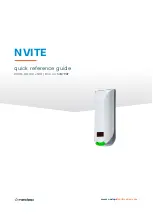
+1-800-661-8443
Third Edition, Nov 2016
ACS V4.2
Page
|
23
Section D. ACS System Operations
D.3
Startup & Operation
To start up your ACS:
Turn power on main panel on.
Flush system manually with beer until foam disappears from each valve head.
Turn vibrator motor on.
Check lid dispenser.
Press start.
D.3.1
Ongoing Operational Checks
Things to monitor while operating ACS include:
CAN JAMS, misfeeds, etc: IMMEDIATELY hit either E-stop button (HMI). Clear the fouled cans. Remove any cans
that might have been crushed by the conveyor gate. Place a seamed can on the can lift table (to prevent cans from
‘walking’ on to platform during seamer start up delay). Ensure cans on conveyor are properly centered under the
fill tubes. Reset the E-stop button. Press Start.
Verify cans are entering the conveyer smoothly.
Watch cans fill and inspect for over foaming and under fills.
Verify lids are dispensing onto cans as they pass under lid slide. If lids ‘miss’ a can, pull a lid manually from the
bottom of the lid tray and place on can before it reaches the pre-load position (in front of Push Cylinder #1).
Verify lids continue to dispense into the slide top-side-up.
Monitor lid sleeve level from time to time to ensure you don’t run out during the canning process.
Check can weights for proper fill levels as often as possible. Records of the weights should be kept.
Full can seam tear down should be done prior to production every day. Can seam height and width should be
checked frequently (once every three to five minutes) throughout production. Production should be stopped if
there is a change of more than 2/1000 on either dimension. A full seam tear down should be performed to
determine the cause of the change and the adjustments required. The procedure for checking the quality of your
seams is a “Can Seam Tear Down”. This enables you to make various measurements as outlined in Section E. Seam
Measurement on Page 37.
D.4
Clean in Place (CIP) System
The system is designed to be relatively maintenance-free. With simple, regular cleanings it should run optimally. However,
with this in mind, it is critical to ensure the equipment is thoroughly cleaned every shift. Due to the sugar content in the
beer it is very sticky when it dries, and this can affect the functionality of some of your moving parts if it is allowed to dry
on them before being cleaned. A proper cleaning should focus on all the splash areas, including the seaming station and
fill location under the lid dispense tray (critical!) but also include the rest of the machine as well.
Use a hose to spray down the whole system and then compressed air to dry as much as possible. What can’t be dried with
air should be wiped down with paper towel or a clean, dry cloth. If you follow this simple cleaning process your machine
will run smoothly with fewer service issues and production interruptions. Refer to this maintenance schedule for an easy
way to keep track of what needs to be done to keep your ACS running as best and as long as possible.
PLEASE ENSURE ALL PARTIES INVOLED IN CLEANING ARE WEARING PROPER PPE (PERSONAL PROTECTIVE EQUIPMENT).
















































